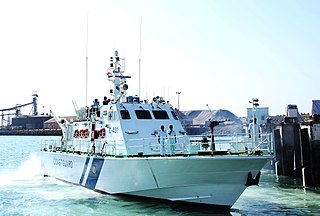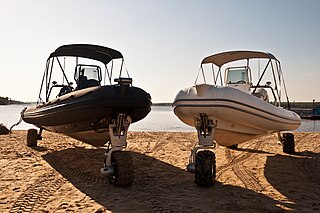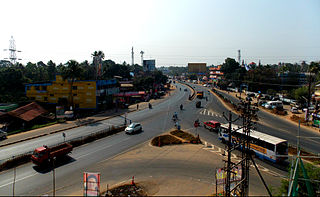
A motorboat, speedboat, or powerboat is a boat which is powered by an engine. Some motorboats are fitted with inboard engines, others have an outboard motor installed on the rear, containing the internal combustion engine, the gearbox and the propeller in one portable unit.

Nathanael Greene Herreshoff was an American naval architect, mechanical engineer, and yacht design innovator. He produced a succession of undefeated America's Cup defenders between 1893-1920.
A Marine surveyor is a person who conducts inspections, surveys or examinations of marine vessels to assess, monitor and report on their condition and the products on them, as well as inspects damage caused to both vessels and cargo. Marine surveyors also inspect equipment intended for new or existing vessels to ensure compliance with various standards or specifications. Marine surveys typically include the structure, machinery and equipment and general condition of a vessel and/or cargo. It also includes judging materials on board and their condition. Because certifications and subsequently payments are processed only after the surveyor has expressed his or her satisfaction, a marine surveyor holds a prestigious position and is held with much regard in the shipbuilding industry. Marine Surveyors are highly qualified and technically sound and are usually selected after thorough evaluation procedures as vessels ranging from small ferries to enormous crude oil carriers and cruise liners are approved to sail into the high seas based purely on their judgment, competence and integrity.

The Damen Group is a Dutch defence, shipbuilding, and engineering conglomerate company based in Gorinchem, South Holland, the Netherlands.

L. (Lewis) Francis Herreshoff, was a boat designer, naval architect, editor and author of books and magazine articles. Early in his career he worked for the Herreshoff Manufacturing and for naval architect Starling Burgess.

The Underfall Yard is a historic boatyard on Spike Island serving Bristol Harbour, the harbour in the city of Bristol, England.

The Royal Cambodian Navy is the naval warfare service branch of the Armed Forces of Cambodia and one of the three uniformed services of the Kingdom of Cambodia. It has an estimated of 4,000 active personnel and operates 228 boats/ships in active service. It is commanded by Admiral Tea Vinh and sails under the jurisdiction of the Ministry of National Defense.
The Herreshoff Marine Museum, located in Bristol, Rhode Island, USA, is a maritime museum dedicated to the history of the Herreshoff Manufacturing Company, yachting, and the America's Cup. The Herreshoff Manufacturing Company (1878-1945) was most notable for producing sailing yachts, including eight America's Cup defenders, and steam-powered vessels.
The Bristol Classic Boat Company is a boat building and restoration company based at Bristol's Floating Harbour, England.
Gulf Craft is a manufacturer of luxury yachts and fiberglass boats based in Ajman in the United Arab Emirates. Gulf Craft operates from three shipyards in the UAE and one in the Maldives.

L&T fast interceptor craft are a series of high-speed interceptor boats being built by L&T Shipyard for the Indian Coast Guard. The ships are intended for patrol and rescue operations in India's Exclusive Economic Zone.
Couach fast interceptor boats are patrol boats being built by the French shipyard Couach Yachts for the Indian Navy.
GSL/GRSE series of Interceptor Boats are Indian high speed patrol boats assembled by Garden Reach Shipbuilders & Engineers Limited (GRSE), Kolkata and Goa Shipyard Limited (GSL), Vasco da Gama.
The ABG class of cadet training ships is a series of three vessels being built by the ABG Shipyard in Gujarat for the Indian Navy.
de Havilland Marine was a division of Hawker de Havilland Australia Pty. Ltd. which is now owned by Boeing Australia and known as Boeing Aerostructures Australia.
Bristol class of interceptor craft are a series of watercrafts built by Bristol Boats, a division of Chika Pvt. Ltd Aroor, for the Indian Coast Guard. These boats are intended for carrying out patrol duties in shallow water areas near the coastline. The contract was signed on 22 March 2004 for acquisition of eight Interceptor Boats by the Indian Coast Guard at a total cost of Rs 3.74 crores. The first craft became operational on 1 December 2004.
Vadyar Boats Pvt. Ltd. is a Chennai based boat manufacturer and marine service provider.
Praga Marine Pvt. Ltd. is a fiberglass boat manufacturing company. It owns a boatyard, located in the backwaters of Cochin at Aroor Industrial Development Area, Allappuzha District It was incorporated in 1985 and commenced business from that boatyard in 1988. It is promoted by Joe Nejedly. His father Josef Nejedly, a Prague-born Czech national was a pioneer of the fibre glass industry in India during the 1960s.

Sealegs Amphibious Craft are a type of amphibious vehicle manufactured by Sealegs International Ltd, a company based in Auckland, New Zealand. Sealegs craft are aluminium fabricated boats fitted with a hydraulic amphibious system. The amphibious system consists of three wheels – one fitted to the bow and two fitted to the transom of the craft. These wheels are lifted, lowered and driven by a hydraulic system which is powered by a petrol engine mounted on the deck.












